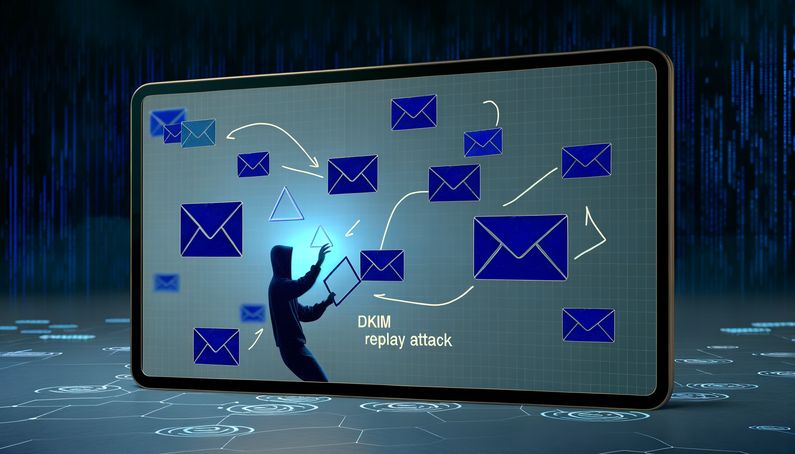
Exploiting Google OAuth: The DKIM Replay Attack Threat
In a world where email security is paramount, phishers have found a cunning way to exploit Google OAuth in a DKIM replay attack, posing a significant threat. Imagine receiving an email that looks exactly like a legitimate alert from Google—only it’s not. This is the reality of DKIM replay attacks, where attackers capture and resend legitimate emails, bypassing authentication checks. (Abnormal AI, Bleeping Computer)
Understanding DKIM and Replay Attacks
Overview of DKIM
DomainKeys Identified Mail (DKIM) is an email authentication protocol designed to detect email spoofing. It allows the sender to attach a digital signature to an email, which is verified by the recipient’s server using the sender’s public key. This verification ensures that the email was genuinely sent from the claimed domain and has not been altered during transit. Think of it as a wax seal on a letter, confirming its authenticity. (Abnormal AI)
How DKIM Works
DKIM works by adding a signature to the email headers. When an email is sent, the sending server generates a unique hash of the email’s content and headers, encrypts it with a private key, and adds it as a DKIM-Signature header. The recipient’s server retrieves the sender’s public key from the DNS records and uses it to decrypt the signature, verifying the email’s authenticity and integrity. It’s like using a key to unlock a box, ensuring the contents are untouched. (Bleeping Computer)
Exploiting DKIM in Replay Attacks
The DKIM Replay Attack Mechanism
A DKIM replay attack exploits the fact that DKIM only verifies the email’s content and headers, not the SMTP envelope. This means that if an attacker gains access to a legitimate DKIM-signed email, they can resend it without modification, and it will pass DKIM verification. The attack involves capturing a DKIM-signed email and replaying it to different recipients, making it appear as though the email is legitimate. (Abnormal AI)
Case Study: Google OAuth Exploitation
In a recent campaign, attackers exploited Google OAuth to perform a DKIM replay attack. They registered a Google account and created an OAuth app with a phishing lure embedded in the app name. By granting the app access to their Google account, they triggered a legitimate DKIM-signed alert from Google. This alert was then forwarded to victims, passing all authentication checks and appearing as a legitimate Google email. (Cyware)
Impact of DKIM Replay Attacks
Bypassing Email Authentication Protocols
DKIM replay attacks highlight a significant vulnerability in email authentication protocols. While DKIM is designed to prevent email spoofing, it does not verify the SMTP envelope, allowing attackers to replay signed emails. This bypasses other protocols like SPF and DMARC, which rely on DKIM results for authentication. As a result, DKIM replay attacks can undermine the effectiveness of these protocols, allowing phishing emails to reach recipients’ inboxes. (EasyDMARC)
Real-World Consequences
The Google OAuth exploitation case demonstrates the real-world impact of DKIM replay attacks. By leveraging Google’s infrastructure, attackers were able to send phishing emails that appeared legitimate, leading recipients to a fake support portal designed to steal credentials. This attack not only compromised individual accounts but also damaged trust in Google’s email security. (Bleeping Computer)
Mitigation Strategies
Enhancing Email Authentication
To mitigate DKIM replay attacks, organizations can enhance their email authentication protocols. This includes implementing strict DMARC policies that reject emails failing authentication checks and using advanced threat detection systems that analyze email behavior rather than relying solely on signature-based verification. Additionally, organizations can regularly update their DKIM keys and monitor for unauthorized access to their email systems. For example, Company X successfully reduced phishing incidents by implementing these strategies. (Abnormal AI)
User Education and Awareness
Educating users about the risks of phishing attacks and how to identify suspicious emails is crucial in mitigating the impact of DKIM replay attacks. Users should be trained to verify the authenticity of emails, especially those requesting sensitive information or containing links to external sites. Organizations can also implement security awareness programs to keep users informed about the latest phishing tactics and how to protect themselves. (Cyware)
Future Considerations
Improving DKIM Protocol
The DKIM protocol could be improved to address its vulnerabilities. This includes extending DKIM to verify the SMTP envelope, ensuring that replayed emails cannot pass authentication checks. Additionally, the development of new email authentication standards that incorporate behavioral analysis and machine learning could provide more robust protection against replay attacks. Imagine a future where emails are as secure as a vault, with multiple layers of protection. (EasyDMARC)
Collaboration and Information Sharing
Collaboration between organizations, email providers, and security researchers is essential in combating DKIM replay attacks. By sharing information about attack methods and vulnerabilities, stakeholders can develop more effective mitigation strategies and improve the overall security of email systems. This collaborative approach can also lead to the development of industry-wide standards and best practices for email authentication. (Abnormal AI)
Final Thoughts
The exploitation of Google OAuth in DKIM replay attacks underscores a critical vulnerability in email authentication protocols. While DKIM is effective in verifying email content and headers, it fails to authenticate the SMTP envelope, allowing attackers to replay emails. This vulnerability not only undermines DKIM but also affects other protocols like SPF and DMARC, leading to phishing emails reaching inboxes. To combat this, organizations must enhance their email authentication strategies, educate users, and collaborate with industry stakeholders to develop robust solutions (EasyDMARC, Cyware).
References
- Abnormal AI. (n.d.). DKIM replay Google phishing attack. Retrieved from https://abnormal.ai/blog/dkim-replay-google-phishing-attack
- Bleeping Computer. (n.d.). Phishers abuse Google OAuth to spoof Google in DKIM replay attack. Retrieved from https://www.bleepingcomputer.com/news/security/phishers-abuse-google-oauth-to-spoof-google-in-dkim-replay-attack/
- Cyware. (n.d.). Google exploit bypasses DKIM protections to deliver realistic alerts. Retrieved from https://cyberinsider.com/google-exploit-bypasses-dkim-protections-to-deliver-realistic-alerts/
- EasyDMARC. (n.d.). Google spoofed via DKIM replay attack: A technical breakdown. Retrieved from https://easydmarc.com/blog/google-spoofed-via-dkim-replay-attack-a-technical-breakdown/



